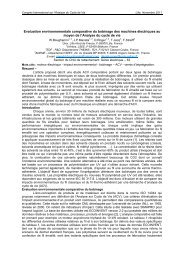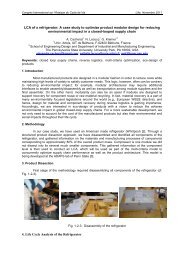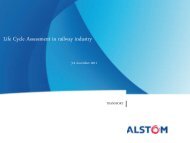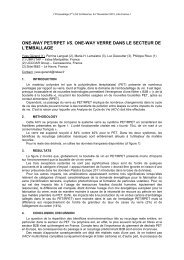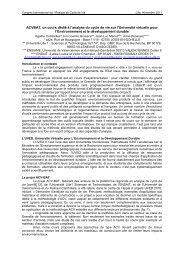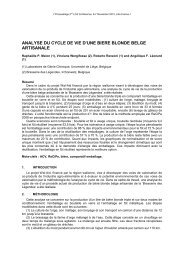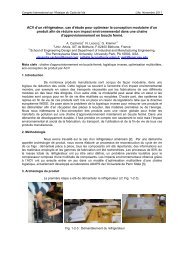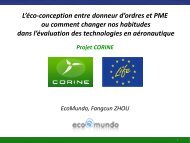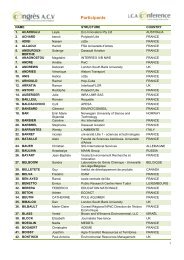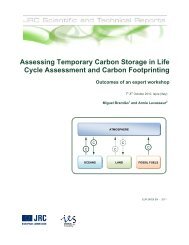Untitled - avniR
Untitled - avniR
Untitled - avniR
Create successful ePaper yourself
Turn your PDF publications into a flip-book with our unique Google optimized e-Paper software.
Climate change Human<br />
Health<br />
Ozone depletion<br />
Human toxicity<br />
Photochemical oxidant<br />
formation<br />
Particulate matter formation<br />
Climate change Ecosystems<br />
Terrestrial acidification<br />
Terrestrial ecotoxicity<br />
Mineral depletion<br />
Fossil depletion<br />
Congrès International sur l’Analyse du Cycle de Vie Lille, Novembre 2011<br />
14000<br />
12000<br />
10000<br />
8000<br />
6000<br />
4000<br />
2000<br />
0<br />
-2000<br />
-4000<br />
Standardization - ReCiPe Endpoint<br />
Without any treatment<br />
With treatment and valorization<br />
FIG. 1: Comparison of standardized environmental impacts with or without treatment of fridges<br />
Important steps<br />
For the old scenario without any treatment, step ii) concerning release of refrigerants and oil<br />
participates the most to the environmental impact followed by the landfilling. Metals recovery permits an<br />
environmental gain and reduces the global score for both scenarios. About the treatment and valorization<br />
scenario, the recycling of different materials such as plastics, glass or metals leads to a negative, i.e.<br />
beneficial, impact. Incineration of refrigerants avoids quite totally their emissions into the air, reducing their<br />
impact on the ozone layer. Energy and material consumptions exert a positive impact which is<br />
compensated by the other environmental benefits.<br />
Conclusions<br />
Results of this study prove the importance of collecting and valorizing fridges especially for old<br />
fridges containing refrigerants banned by the Montreal Protocol. Recovery and incineration of these<br />
pollutants permit to greatly reduce climate change and ozone depletion impacts.<br />
References<br />
[1] Van Gansewinkel, Average composition of a fridge, 2010.<br />
[2] ISO(2006). ISO 14040 : Management environnemental – Analyse du cycle de vie – Principes et<br />
cadre, ISO.<br />
[3] ISO(2006). ISO 14044 : Management environnemental – Analyse du cycle de vie – Exigences et ligens<br />
directrices, ISO.<br />
[4] Goedkoop, M., R. Heijungs, et al. (2009). ReCiPe 2008 - A life cycle impact assessment method which<br />
comprises harmonised category indicators at the midpoint and the endpoint level. Ruimte en Milieu.<br />
[5] Van Gansewinkel, Energy and material consumptions, 2010.<br />
[6] ecoinvent Centre (2010). The life cycle inventory data version 2.2. , Swiss Center for Life Cycle<br />
Inventories.<br />
Acknowledgement - The authors thank Van Gansewinkel and Intradel for their collaboration and avalaibility<br />
in this study.<br />
- 102 -



